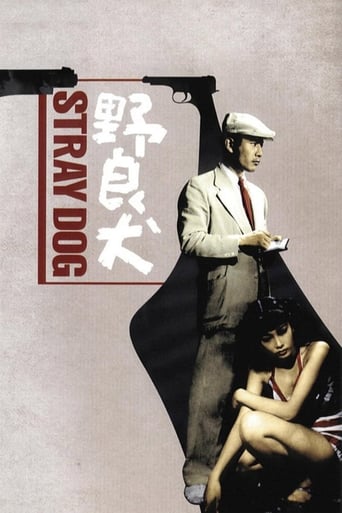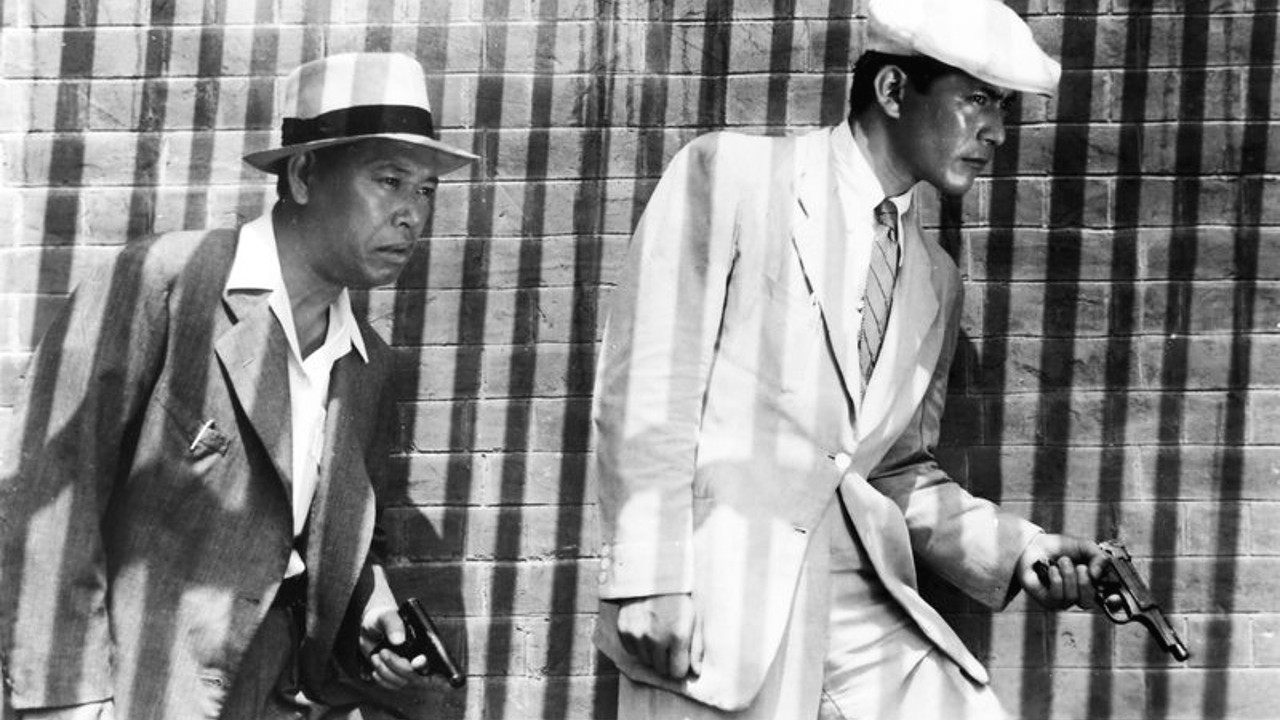dee.reid
Akira Kurosawa co-wrote and directed his black & white detective-noir "Stray Dog" in 1949 - one year before the international break-out success of "Rashomon" (1950). In post-World War II Tokyo, Japan is still in the midst of recovering from its defeat in that devastating conflict. (While the country is obviously in shambles, incredibly enough, we never really see any of that, but still, its psychological impact is felt everywhere you look. But then again, this film is not about Japan's post-war-era of reconstruction.) During a sweltering summer heatwave, a pistol belonging to young Detective Murakami (a young Toshiro Mifune, one of Kurosawa's cinematic regulars) is stolen by a pickpocket while riding on a crowded city bus one day. The weapon changes many hands over the next few days, eventually winding up in the hands of a disgruntled World War II vet, later identified as a young man named Yusa (Isao Kimura). Murakami, also a war veteran, becomes obsessed with retrieving his gun, since it is used in a series of escalating, violent incidents around the city. During this time, he is also partnered up with an older, more experienced homicide detective, Sato (Takashi Shimura, another Kurosawa regular, most famous for "Ikiru" and "Seven Samurai," perhaps), to nab Yusa, the so-called "stray dog" of the title. "Stray Dog" is yet another classic from Akira Kurosawa. The film is nicely and beautifully shot; Kurosawa was a favorite of using the natural weather conditions to symbolize things happening on-screen, and here he uses the heat to great effect. Like how Spike Lee would do on "Do the Right Thing" 40 years later in 1989, we can feel the heat and how the tension, and Murakami's increasing anxiety and desperation, at solving his case before more people are hurt, affect him on a deeply personal and psychological level. Rain, which you would think would cool things down a bit, here, represents yet another escalation in things to come later on in the film. Perhaps one thing that "Stray Dog" illustrates best is that Murakami, in a way, is just like Yusa. As someone else also pointed out, both fell on hard times after their war service and were angry and frustrated at their circumstances, but Murakami picked himself up afterward. Also as someone pointed out, that means that, sometimes, the only thing that separates the two men from each other is the notion of choice - since Murakami explains that he could just as easily have become just like Yusa at some point.This movie is not to be missed if you're a true fan of the cinematic master craftsman, Akira Kurosawa.10/10
Charles Herold (cherold)
This police procedural has the interesting premise of a cop obsessed with finding his stolen gun, and his sense of responsibility for everything that happens because of the theft. It's an interesting idea, a sort of cop version of Bicycle Thieves, but it's a bit slow and static. For all the comments here that call it a film noir, it lacks that sort of intensity, although it does have interesting anti-noir qualities - much of it takes place in daylight among people wearing light colored clothes.Even at its weakest, there are interesting Kurosawa touches throughout, most notably the use of the oppressive summer heat as a character in the film. And while some moments feel overlong, such as the cop's undercover work, there are nice bits like his dogging a suspect or that suspect's later interrogation by an older and wiser cop.The movie hits high Kurosawa in its fantastic forth. From a stunning image of a girl twirling in a dress just as a thunderstorm breaks,the film is everything you expect from the great director, as though a more experienced Kurosawa had jumped into a time machine to do the last part, and the final confrontation is brilliant, even if the movie's last short scene is as flat and dry as the first ones.Kurosawa has made much better movies, but there is enough of interest in this one that fans of the director should check it out at some point.
Alex da Silva
Rookie detective Toshiro Mifune (Murakami) gets his gun pick-pocketed and embarks upon a journey to retrieve it. He starts out alone but eventually teams up with a wiser cop played by Takashi Shimura (Sato). All the while, his gun is being used in more and more deadly crimes and his sense of shame and dishonour drives him onwards to rectify the situation. The gun has seven bullets, and by the end of the film, all of them have been fired.Director Akira Kurosawa delivers a high quality effort in capturing a tense atmosphere and stifling Tokyo heat. The characters are entertaining and the dialogue realistic with some memorable scenes, eg, the chorus of girls dancing in the nightclub and then running backstage to relax - this is where we first encounter Keiko Awaji (Harumi Namaki), who has a significant role as the killer's girlfriend. We are led to believe that Mifune has many similarities with the killer Isao Kimura (Yusa) – they have just chosen different paths.I must mention the dialogue - one particular gem is the moment when a woman's emotional behaviour is very frankly put down to her being on her period. How true. Hollywood just wouldn't dare.The film draws you in from the start, although it's overall length could be shortened. There is one scene which is a montage of shots of Mifune wandering around the shady districts of Tokyo. Whilst the accompanying music to this is interesting, we get the point after a couple of minutes. There are a few sections like this where the director drags it out a little too long. A good film. No-one has mentioned this yet but is it significant that Mifune doesn't actually speak his dialogue - he barks it like a dog?
Patryk Czekaj
It has always amazed me that Akira Kurosawa managed to adapt to any kind of genre with such incredible ease, every time attracting the attention of the whole world. As one might have expected, it's also happened in the case of Stray Dog. Although the picture is greatly influenced by the western noir genre and it looks but that way, it clearly possess this mesmerizing Japanese touch, making it even more astounding and provoking than many classic American crime pictures. It's a great detective story with a lot of sudden twists and turns in the thrilling story. What's fascinating about Stray Dog is the fact that it starts with such a seemingly trivial matter like a stolen gun, but proceeds to develop a mostly riveting intrigue filled with unnecessary murder and deep obsession.The storyline closely follows Detective Murakami (Toshiro Mifune) who – along with Detective Sato (Takashi Shimura) – embarks on a dangerous journey in order to find his precious Colt. With every discovery the story becomes more complicated and sombre. One dead body leads to another. As the film gradually changes its tone and intensifies the pace, it also creates a mightily mystic and overwhelmingly suspenseful atmosphere. When the mood alternates, the murky cinematography begins to uncover a darker side of the picture. It's fascinating how – through slow movement and ubiquitous sweat trickling down the characters' bodies – Kurosawa pictured the tremendous heat that permeates every scene. What's more, through the contradiction of two differing viewpoints – that of a young cop and that of an older cop – the film alternates between two contrasting perceptions of the events and doesn't clarify which one of them is valid.This is yet another amazing collaboration between Kurosawa and Toshiro Mifune. Every picture they filmed together turned out to be a huge hit, and Stray Dog only confirms the trend. Mifune plays an emotional and inexperienced detective who is at first more concerned about his beloved gun than about other people's lives. On the opposite side there is Takashi Shimura, who gives a marvelous performance as Murakami's likable and enormously calm acquaintance Sato, who tends to rely on his intuition and not on his feelings. And as the two characters bond, Sato tries to teach his companion the old-fashioned yet perfectly plausible rule – don't sympathize with the suspects, as you might become too weak and unable to fulfill your duties as a policeman.Through this thrilling tale of mystery and murder Kurosawa was also able to show his personal view on the tough situation in post-war Japan. It's his auteur take on the struggling middle class, its members, and the crimes that those people have to commit in order to make ends meet. All the brutality, inhumanity and deception presented in this movie are caused mainly by the inequality in Japanese society. Apart from creating a visually stunning masterpiece and a truly compelling detective story, Kurosawa also skillfully persuaded the audience that behind most violent acts hides a purpose, even when it all seems like the work of a titular stray dog. Still, ironically so, those terrifying creatures have to suppress their urges as well, but with every subsequent act of violence their hunger and anger rise to the level of murder. And that's definitely too hard for the protagonists too grasp.


 AD
AD



